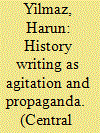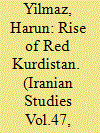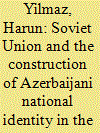|
|
|
Sort Order |
|
|
|
Items / Page
|
|
|
|
|
|
|
| Srl | Item |
| 1 |
ID:
116074


|
|
|
|
|
| Publication |
2012.
|
| Summary/Abstract |
The reconstruction of the Soviet recent past is a controversial issue in the post-Soviet republics. In Kazakhstan, the reconstruction of the past has gradually rehabilitated leading Kazakh communists, such as Zhumabai Shaiakhmetov. One of the main rationales of this rehabilitation is his support for Kazakh historical writing, which resulted in a textbook published in 1943. This work has been seen as an endeavor by 'patriotic' Kazakh officials and historians to defend Kazakh national heritage against the 'Soviet colonial empire'. By presenting a broader view of the war period in Kazakhstan from the archives, this article argues that this history textbook was in fact merely an agitation-propaganda product of the Communist Party of Kazakhstan. Shaiakhmetov and others had mostly secured their career by remaining loyal to the Soviet system during the collectivization, the Great Famine and the Great Terror. Therefore, their encouragement of the publication of a national history in 1943 for propaganda purposes does not qualify them as suitable predecessors of the current generation of Kazakh rulers.
|
|
|
|
|
|
|
|
|
|
|
|
|
|
|
|
| 2 |
ID:
133822


|
|
|
|
|
| Publication |
2014.
|
| Summary/Abstract |
Current literature on twentieth century Kurdish history overwhelmingly covers Kurdish populations and national movements within the borders of Turkey, Iran, Iraq and Syria. This article, hoin Armenia, Georgia, and Azerbaijan,ever, focuses on Soviet Kurdistan and Kurdish policy in Azerbaijan between 1920 and 1937 through the broader question of national minorities within the republic. It is claimed here that the Soviet policy on Azerbaijani Kurds was part of a multilayered issue. First of vnall, the Kurds of Azerbaijan were semi-nomadic mountain dwellers transformed by the modernization policies implemented in Soviet territories. Azerbaijani Kurds were a national identity within the Soviet Union and thus subject to ethnophilic All-Union policies in those years. Finally, Kurds were one of the numerous national minorities in the Soviet Socialist Republic of Azerbaijan who were exposed to the national minority policies executed within the republic by the administration in Baku. The national minority policy in Azerbaijan was often contested and limited by local conditions and obstacles. Therefore, the granting of cultural rights in the 1920s to national minorities, which included the Kurds of Azerbaijan, the promotion of these rights in the 1920s and 1930s, and opposition to these policies can only be examined with regard to these three layers.
|
|
|
|
|
|
|
|
|
|
|
|
|
|
|
|
| 3 |
ID:
128565


|
|
|
|
|
| Publication |
2013.
|
| Summary/Abstract |
Although the titular nation of the Azerbaijan Soviet Socialist Republic was Turkic speaking and had strong cultural and historical ties with Iran, the Soviet regime constructed a national identity that was divorced from its Turkic and Iranian past. The current literature cannot provide the exact period when this construction was put forward and generally argues that the Azerbaijani identity was artificially created as part of a broader "divide-and-rule" policy that was applied to all the Turkic nations in the Soviet Union. However, this thesis by itself does not explain why this change from a Turkic identity to an Azerbaijani one happened seventeen years after the Bolsheviks assumed power in Baku, and its simple causation makes it sound more like a conspiracy theory, which had a certain popularity in the Cold War era, than a scholarly argument. By presenting a broader view, the paper explains why and when the national identity in Soviet Azerbaijan was altered from Turkic to Azerbaijani. It argues that there were many factors that induced the Bolsheviks to take this extraordinary step in 1937. In fact, the change in defining national identity in Azerbaijan was a result of a combination of developments in the 1930s in Turkey, Iran, Germany, and the Soviet Union. The article concludes that these developments left Soviet rulers no choice but to construct an independent Azerbaijani identity.
|
|
|
|
|
|
|
|
|
|
|
|
|
|
|
|
|
|
|
|
|